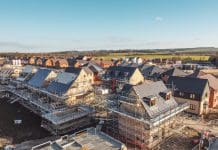Amidst the housing crisis, the government’s present strategy of encouraging greater housing diversity should be commended. But care needs to be taken not to introduce overly interventionist guidance that may slow build-out and create rifts between local authorities and developers, says Martin Herbert, director of planning at WYG
The February update to the National Planning Policy Framework (NPPF) is clearer and stronger in its expectation that the planning process will address the needs of groups with specific housing requirements. For example, at least 10% of homes in major development sites must now be for affordable ownership as part of the overall affordable housing contribution. But this should not come at the expense of providing for other specific groups, such as Build to Rent, the elderly, students, self-build or where development is already affordable.
The government sees planning for larger-scale development like new settlements or extensions to existing towns and villages as the most appropriate and sustainable way to provide a variety of homes for different groups in the community. Creating healthy, inclusive and safe places will also promote an environment of social interaction between people who might not otherwise come into contact.
Amongst its findings, the government’s independent review of housing build-out rates, chaired by Sir Oliver Letwin, has concluded that more varied types, tenures and designs of housing on large sites would increase
market absorption rates of new homes – something secretary of state James Brokenshire has welcomed. Following encouragement in the NPPF, it has also been suggested that the Ministry of Housing, Communities & Local Government (MHCLG) will shortly issue additional planning guidance on diversification so large sites can more easily support a wide range of homes and build them out faster.
What should this new guidance contain? Should it be kept fairly high-level and merely provide an indication of specific tenures or house types the government is keen to see on larger sites? That would not go much farther than what already appears in the NPPF.
Alternatively, there could be some indicative thresholds or support for phasing programmes that prioritise the delivery of certain tenures. Or one could go further still and write a housing diversity menu into a design code so it applies to a specific site, rather than devise a policy for an entire local authority area.
Apart from affordable housing policies, local authority plans for housing diversity are currently largely aspirational. You may find ‘guidance’ on the sectors to be provided for when master planning large sites, but it usually amounts to a basic wishlist. Reference is often made to needs calculated in the Strategic Housing Market Assessment (SHMA) that forms part of the local plan evidence base, but there is no clear mechanism in policy for delivering those specific needs, other than generally for affordable housing.
For example, the draft London Plan policy that deals with housing size mix includes the London SHMA as just one of 10 considerations to be made when determining the appropriate mix of unit sizes. The mayor, however, asks that boroughs do not set proportions of different-sized market or intermediate units. As such, policies are considered inflexible, they’re often not implemented effectively and do not reflect the optimum mix for a site, nor do they necessarily meet the need for which they are required.
For these reasons, it seems unlikely the anticipated guidance from government will be too prescriptive. Developers will undoubtedly oppose anything more demanding than high-level encouragement, on the grounds of viability. The simple calculation of a viable percentage of affordable housing has caused vast disagreement between developers and local authorities, pursued through the planning system and often to appeal. One can imagine this will only increase with requirements to deliver specific proportions of different types of housing, especially on large sites that may evolve over a programme of 20 years or so.
The Letwin Review has reached the important conclusion that increased housing diversity will speed up build-out rates on large sites. This is likely to have the added benefit of improving design quality and potentially creating more attractive places.
Letwin suggests specific levels of greater housing diversification can be funded through land value capture. However, the government has said it is more focused on evolving the existing system of developer contributions (S106) but that it will keep reviewing the need for further interventions to support housing diversification and faster build-out. This further suggests the forthcoming planning guidance is more likely to act as encouragement aimed at local authorities and Homes England to identify suitable (large) sites with opportunities for further diversification.
We should probably not raise our expectations too high for the forthcoming diversity guidance. That it is on the government’s planning agenda at all should be applauded, but encouragement is likely all we will get. Too prescriptive an approach is fraught with practical difficulty, and who can accurately say what the detailed mix of a 1,500-home development will be over a delivery period of 10 years or longer? The desire for developer flexibility will conflict with attempts to fix the detail on day one, and the resultant drawn-out debates will undermine the very objective of speeding up build-out rates.
The guidance from the government will provide local authorities with extra support for more effectively meeting needs and creating better places, more quickly. But over-prescriptive policies are likely to result in new sources of delay to development – precisely what we all want to overcome.

Martin Herbert
Director, Planning
WYG
Tel: +44 (0)113 278 7111
Twitter: wyggroup
LinkedIn: wyg-group
Facebook: WYG
Instagram: wyggroup














